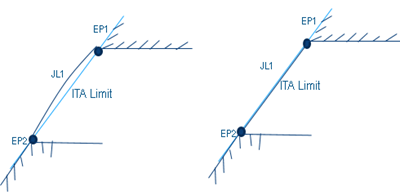Using the Iso-Thickness Junction Wizard | |
| |
- Select a group of iso-thickness areas.
- Optional: Select a geometrical set containing all the existing junction lines (to verify and validate existing junction lines).
-
Optional: Select the Optimize the input junction
lines check box.
This check box is available only for a relimited ITA Group (created using an ITA limit).
- Small inaccuracies found in the selected junction lines are corrected during
computation. Below are three examples of correction when there is a gap between the
junction line and the ITA limit:
- In the case below, the number of junction lines remains the same.

- In the case below, an extra junction line is created.

- In this last case, the junction line deviated from the ITA limit, because of the
high curvature of the underlying surface. After optimization, it is correctly
aligned.

- In the case below, the number of junction lines remains the same.
- A set of Imposed Thickness Points (ITP Set) is created. The ITPs are identified in the 3D area. Solid From Iso-Thickness Areas uses this ITP Set to ensure that the elevation height/offset at these points is equal to the thickness specified with the ITP.
Tip: Verify the optimization result under Check and Refine Results. - Small inaccuracies found in the selected junction lines are corrected during
computation. Below are three examples of correction when there is a gap between the
junction line and the ITA limit:
- Optional: Select Do not compute junction lines
-
Optional: If you have selected an existing Junction Line Set as input,
select the Create junction lines in new Geometrical Set check
box.
- If you have selected Optimize the input junction lines, the new set of junctions lines contains both optimized and non-optimized junction lines.
- if you have not selected Optimize the input junction lines, the new set of junction lines contains the existing ones and the newly created ones.
- In both cases, the existing set is put in NoShow.
- Click Edit to edit the iso-thickness areas group.
-
Click Compute.
- The wizard finds all the points at the corners of the iso-thickness areas of the group.
- If a line between two points intersects an iso-thickness area, this line is not considered a potential junction line.
- If a line between two points does not intersect an iso-thickness area, this line is considered a potential junction line.
- The analysis produces several groups of points.
- If a group contains only two points, the line between those two points is proposed as a junction line.
- If a group contains more than two points, they are joined two by two. If plies corners coincide with a line, this line is proposed as a junction line,
The dialog box is populated with the result of the computation. The groups are displayed in the order of the statuses:
The groups of points are also displayed in the work area:
- With their thickness.
- With the traffic light representing their status.
- With a dotted green line is the status is green but not yet validated.
- With a solid green line when it is validated.
- With a solid blue line when the junction line is part of an existing set.
-
If you have selected Optimize the input junction lines, click
Edit ITPs to inspect and edit the created ITPs.
-
Select a line to reframe on the ITP.
Multi-selection is available.
The thickness of the ITP is displayed in the 3D area. - Edit the thickness in the Thickness box.
-
Select a line to reframe on the ITP.
- Select the required 3D Display options.
- In the dialog box, select one or several lines and click Validate to validate the corresponding junction lines.
- In the 3D area, drag the cursor over a vertex.
-
Click a point
and drag the cursor.
The red dotted lined turns green when reaching a point belonging to another iso-thickness area or standard point, meaning a junction line will be created.
- To remove any potential or validated junction line, drag the cursor over the line until a red cross appears. Click that red cross. The junction line is removed from the preview and not created.
- Click a traffic light.Its junction lines are validated.
- Check and validate all the groups.